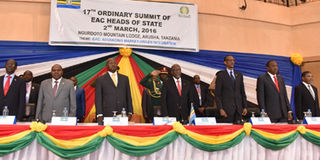A lot is expected from meeting of eac heads

What you need to know:
- The retreat aims at accelerating attainment of the objectives of the EAC development strategy, AU’s Agenda-2063, and the infrastructure and health sectors of the UN-backed SDGs (Agenda-2030).
The joint East African Community (EAC) heads of state retreat that begins Thursday covers assorted critical issues. There is a lot of expectation as regional leaders meet in Kampala. Key events are the 4th EAC Heads of State Retreat on Infrastructure Financing and Development, the 1st EAC Summit on Investment in Health and Health Sector Investors and a donors roundtable.
The retreat aims at accelerating attainment of the objectives of the EAC development strategy, AU’s Agenda-2063, and the infrastructure and health sectors of the UN-backed SDGs (Agenda-2030).
The ministerial-level donor roundtables are expected to generate refined outcome documents on infrastructure and health financing and development to be presented to the joint retreat. EAC states will showcase prioritised projects, and engage with prospective investors for uptakes.
Therefore, the retreat is expected to give impetus to infrastructure and health development by way of possible funding commitments, political support to flagship projects, possible Public Private Partnerships and a projects implementation roadmap. Indeed, the summit on investment in health is the first and biggest-ever event of the EAC heads on health.
It’s also most opportune – especially because our region is undergoing major public health transformation fuelled by changing human, animal and environmental interactions, population dynamics and lackadaisical socio-economic development.
Like other low and middle-income regions, East Africa is concurrently bearing the burdens of common infectious diseases, such as malaria, HIV/Aids and tuberculosis, as well as maternal and child health complications. The region also labours under various non-communicable diseases.
This could be what the doctor ordered – and was long overdue. Let it not be just another retreat.
Schools found wanting
A recent study by education advocacy group HakiElimu has revealed that the learning environment in inclusive schools in Tanzania is relatively unfriendly for visually impaired children. While the findings come as not much of a big surprise, they still serve as a timely reminder that something still needs to be done beyond policy to improve the lot of disabled students in our schools.
The study titled ‘Examination of Learning and Participation of Visually Impaired Students in Inclusive Schools’ was conducted at the end of last year in public primary and secondary schools with visually-impaired learners in nine regions of Dodoma, Iringa, Lindi, Morogoro, Mwanza Ruvuma, Shinyanga, Tabora and Tanga. One of the unfortunate findings is that 79 per cent of teachers admitted that visually impaired children were stigmatised by fellow students.
There is also the sad fact that a significant number of education officers interviewed in the survey are not aware of the country’s inclusive education strategy aimed at making life better for disabled students in public schools. In addition, there is the shortage of qualified and competent teachers and limited access to various places within the schools due to unfriendly infrastructure. These challenges need to be addressed beyond policy.




